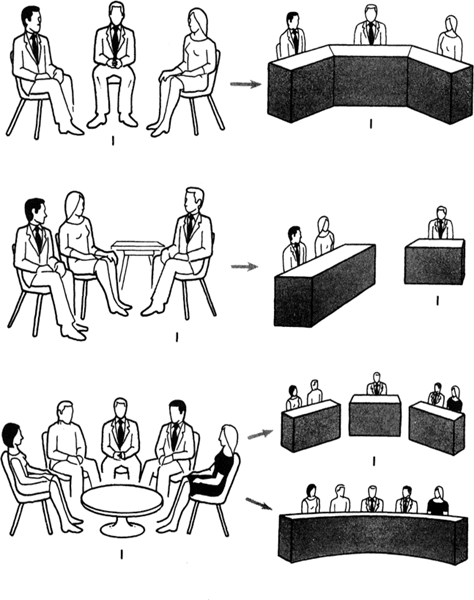Talk Shows
All talk shows follow a common theme; a group of people sitting in formalized arrangements, talking. The programs themselves may vary from a panel game to a press conference, from a discussion group to an audience quizzing a group of experts. But the production treatment is similar enough.
Controlling the program
Names abound for the person who is guiding and controlling what is going on in front of camera – aided by the director’s intercom earpiece instructions, and the FM’s signals: Presenter, Anchor person/Anchorman, Chair person/Chairman, Link-man, Master of Ceremonies/Emcee (MC), Host, Interviewer, Coordinator, as well as the more specialized assignments such as Announcer, Sportscaster, Commentator.…
Like the interviewer, this person needs research briefing, to be familiar with the production’s aims and details. He/she will guide discussion, be aware of time allowances, and introduce the topics and the guests/participants to the viewer. The ‘presenter’ controls discipline, by encouraging one person to speak at a time, preventing undue dominance, steering discussion back to the subject, maintaining it along the planned lines. The presenter’s particular talents reach their zenith when there is an on-air crisis, for then they will anticipate problems, improvise, stall … anything to keep the show running smoothly.
Layout
The layout for a talk show usually consists of a series of chairs or desk setups, arranged perhaps on a low platform (rostrum) in front of a cyclorama or series of scenic flats.
Groups of chairs tend to look unattractive; particularly in longer shots. On the other hand, more casual seating such as sofas and armchairs are cumbersome, and make shot continuity and grouping more difficult So the practice of using scenic ‘desks’ evolved. These ‘dress up’ the presentation, and add a sense of occasion or formality. They keep people close together, and avoid the ‘forest of knees’ effect seen on camera when shooting, lines of chairs.
Typical shots
In talk shows, intercut single closeups, two-shots and group shots are the regular diet; with the occasional overall view (cover shot), and perhaps a cross-shot (side shot), or over-shoulder shot Because sustained pictures of individuals soon pall, the director will usually intercut reaction shots of different members of the group. These can help to establish a feeling of rapport (or antipathy!) between the speakers. But do avoid the vacant gaze, and the preoccupied or disinterested look – unless, of course, that is appropriate comment! ‘Reaction shots’ showing hands nervously tapping or the fingers intertwining with anxiety are easily overdone.
In some situations, people speak in an agreed order. But in an ad-lib discussion, it may be prudent to have one camera continually taking wide shots, to give you a picture to cut to, while another camera seeks a closeup of the new speaker.
Layouts
Layouts for talk shows can be arranged to provide individual Impact (people in chairs!, or to create segmented unity fpeople are divided into sections), or to present group unity (in an assembly). The interviewer (I) or chairperson/link/anchor, has a coordinating role. Each layout has its particular convenience and adaptability. Desks add formality or a sense of occasion.

